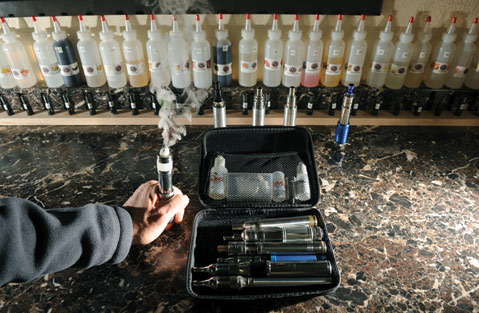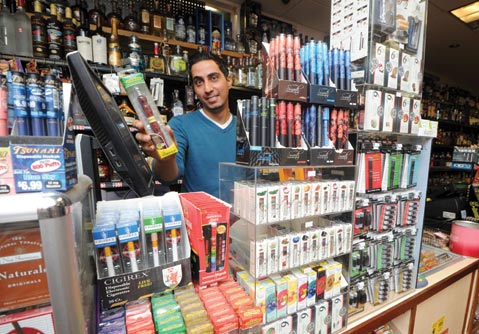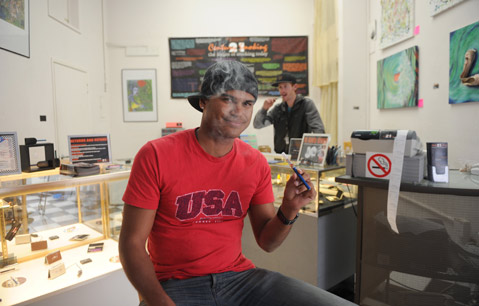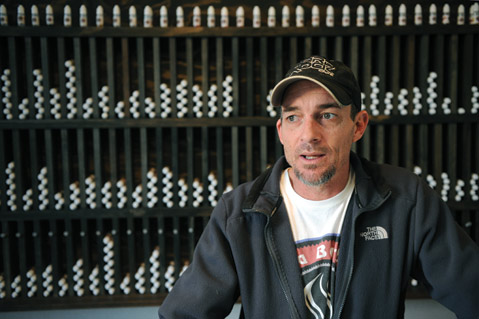The Retail Side of E-Cigarettes
Investigating the Customer Connection

Whether you’re a nicotine addict, curious consumer, or “cloud chaser,” your options for buying cheapie, disposable e-cigarettes all the way up to high-end “vape pens” are roughly limited to three types of stores. Santa Barbara has them all, and is quickly getting more.
Last week, Thousand Oaks–based Vapor Connection opened in Isla Vista, and a handful of other businesses have cropped up between Carpinteria and Goleta in just the past few months. The fast-paced growth, like many a South Coast trend, has origins in Los Angeles, where small retailers and major wholesalers alike are digging deeper into SoCal’s economy and culture.
While every Santa Barbara area store is different — selling various brands and qualities of merchandise with fluctuating levels of expertise and accountability — they all exist within a regulatory loophole since city, county, and state business permit codes have yet to catch up with e-cigarette technology. Unlike traditional smoke shops and corner stores, these locations don’t need to apply for tobacco-retailer licenses since they don’t dispense the nicotine-laden leaf. And the nicotine they do sell — liquefied and mixed within the flavored solution that all of the devices contain — isn’t yet specified in bylaws.
Some stores, for the sake of transparency, get a tobacco permit on top of their normal business license. Others don’t. Some landlords allow employees and customers to vape inside their buildings. Others don’t. Some neighbors welcome the merchants and their clientele. Others don’t. Regardless, e-cigarette vendors enjoy an existence that’s by and large free from government regulation, but they’re under no illusion this new Wild West of retail will last forever.

Along for the Ride
Sam Maida, owner of Presidio Market on Santa Barbara Street, is one such realist, and his shop represents the first category of e-cig establishment: the corner store that’s jumped on the vape craze bandwagon and hawks a myriad of inexpensive, mostly single-use devices as well as a few mid-range rechargeables. (Disposable versions, which typically go for around $10, deliver the same amount of “puffs” as two packs of regular cigarettes. Rechargeables, which can be refilled with the flavored nicotine solution, a k a “juice,” usually cost between $20-$30.)
Maida said he’s waiting for the other shoe to drop, for a new tax to be levied on the handheld vaporizers, but in the meantime, he’s enjoying the profit they bring of around $500 a day. Now occupying an ever-growing space around his cash register next to alcohol and gum, the devices started off prohibitively expensive — $150 a pop — five years ago. They’ve only gotten cheaper and better since. “This is the future,” declared Maida, who had just picked up an $8,000 shipment from his L.A. supplier the day before our interview. “I’m telling you, it’s a whole new world.”
E-cigarette manufacturers, of which there are dozens, often mimic the color-coding scheme adopted by tobacco companies: red for regular, blue for light, silver or gold for ultralight, and green for menthol. Popular varieties at Presidio include Maya and NicMaxx. And while Big Tobacco had largely stayed out of the vape market, corporations like Lorillard, Inc. (Newport) and Reynolds American Inc. (Camel) recently launched their own e-cigarette lines, with Altria Group (Marlboro) trailing not far behind.
Maida explained all this as he puffed on his own vape pen and laid out a potpourri of different styles and brands on a table at (805) Deli, which he also runs. The most well-liked flavors he carries include strawberry and apple, and the more exotic sounding the name — like guava kiwi or cinnamon chocolate — the faster they fly off the shelf. The e-cigs meant to re-create hookah-smoking sensations and flavors are gaining in popularity, Maida went on, especially with younger buyers. Women make up a large portion of his customer base, and he has a hard time keeping pink-colored devices in stock. Most of his vaping clientele is white, he said.

Haley Street Hustlers
Over at 21st Century Smoking on Haley Street, store manager Jordan Cox said his e-cig business is only getting better with each month that goes by. “We don’t do much in the way of advertising,” he said. “They sell themselves.”
The company — which started four years ago in a Ventura mall kiosk, chose Santa Barbara as its second location in 2012 and now boasts 13 shops around the country — occupies a specific niche by offering three mid-range, proprietary vape pens. Made in China and sold with a lifetime guarantee, 21st Century Smoking’s options cost between $10-$60 and are named The Blackjack, The Roulette, and The Big Slick because the owner, S.B. resident Brandon Duke, is a big fan of Las Vegas.
Cox said he sells e-cigarettes on the premise that they absolutely help a person quit smoking. “They have a much higher success rate than the gum or the patch,” he claimed. But more and more, he went on, customers are buying the devices without nicotine, instead just vaping the sticky-sweet juice for the flavor and fun. “A lot of college kids want to use it like a hookah,” Cox explained while lounging in one of the store’s leather couches, the leashed cat next to him watching a TV playing Star Wars. Fully committed to his client base — who range from 18- to 80-year-olds — Cox said he often gives out his cell number and will keep the shop open until 1 or 2 a.m. in case one of them needs to refill their supply of solution or replace a broken battery.
When first-time buyers inquire about their options, Cox asks them what brand they smoke and how much. That helps him determine what traditional flavor they might like best — Vegas flavor, for instance, is supposed to taste like Camel products — and what strength of nicotine he should add to their juice, whether it’s 6, 11, or 16 milligrams for light to medium smokers, or 24 or 36 milligrams for heavy smokers. If the customer wants to spice up their vaping experience, Cox went on, 21st Century has more than 30 custom flavors of liquid to choose from, including almond, blue cola, cheesecake, and rum. He offers a sample of watermelon. It tastes like watermelon. “If I put a drop of pineapple in there,” he smiled, “it’s ridiculous.” Cox explained it’s not unusual for someone new to e-cigarettes to “smoke” them more often than they did regular cigarettes because they’re so tasty and convenient. “It’s all about finding balance,” he cautioned.
Making more than 40 transactions a day, Cox called any pending regulations on the e-cig market that might limit supply and increase cost “unfortunate.” “People are trying to stop smoking,” he complained. “Why would you try and hinder that?” Cox expounded on the benefits of vaping — it doesn’t turn ceilings yellow, the smell dissipates right away, etc. — but said he hasn’t read any of the recent health studies on the purported risks of vaping nicotine. “I don’t want to know,” he said. A moment later, an employee from next door’s Magic Pita Café came by to say hello to Cox. He had nothing but positive reviews for 21st Century. “They’re awesome,” he said while taking a drag from his glowing device.

Vapes R’ Us
William Huff, who opened Santa Barbara Vapor on Fairview Avenue seven months ago, is a true vapologist. While he similarly believes electronic cigarettes can help a person limit or stop smoking real cigarettes — he points to himself as an example — Huff nevertheless issues the disclaimer that “Anything you inhale into your lungs is probably not good for you.” Even so, the fear-driven backlash that used to greet vape stores has noticeably lessened in recent memory, he said, as more and more positive reports are issued on the benefits of vaping versus smoking. “This will probably be the future of smoking,” he stated. “It’s been very exciting, very new.”
The store, which has the feel of a head shop, with items unfamiliar and intriguing laid out in well-lit glass cases, was chosen specifically because it’s next to a bar, Break Time, that proved a predicted boon to business right from the start. Huff sells a number of different high-end, rechargeable, customizable units — sometimes referred to as “mods” — that start at $30 and run up to $125. He often recommends a $40 “starter pack” to rookies that includes a refillable vape pen, charger, and bottle of juice. Seasoned users will often trick out their mods with new drip tips and OHM meters, and rebuild their device’s coil system to better control heat output. “It’s becoming a hobby and a culture,” Huff said. “There’s a lot of accessorizing.”
So what makes one vaporizer better than another? “The amount of vapor you get per drag,” Huff explained. “People are looking for that throat hit.” The thickness is dependent on the amount of nicotine in the solution, the richness of the flavor (brownie and chocolate work particularly well), and the ratio of the juice’s two main ingredients: glycol and vegetable glycerin. As much as a quarter of Huff’s clients vape solely for the plume effect, without adding nicotine. These “cloud chasers,” said Huff, take particular pride in their mods and thick exhales.
Unique to his store, Huff — born and raised in Santa Barbara — allows customers to create their own juices by blending the variety of concentrated food flavoring on tap. He then adds the nicotine himself for the sake of safety and control. While the glycol, glycerin, and flavoring are all regulated by the FDA, Huff said, the combination is not. If he had to guess, the first round of regulation will likely fall on fluid manufacturing and the spaces in which they’re created. The hardware, almost exclusively manufactured in China, would probably come later, he said, noting the more popular juice brands are actually cooked up in the United States. The gear they sell is imported wholesale with a 100 percent markup.
Like other e-cig and vape store owners, Huff gets asked with relative frequency about vaporizing hash oil and other marijuana derivatives. While he can’t and won’t tell curious parties how to vaporize those drugs, he “can guide them in the right direction.”
Though relying solely on word of mouth and the occasional flyer to promote his business, Huff has run in the black since day one and hopes to soon open another storefront in downtown Santa Barbara. And when the D-day of regulation comes, he said he’ll be ready with a transparent approach and respect for the law. “I look forward to going in front of the City Council,” he said.



